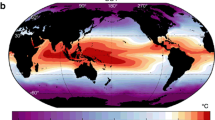Abstract
This study performs a comprehensive feedback analysis on the Bureau of Meteorology Research Centre General Circulation Model, quantifying all important feedbacks operating under an increase in atmospheric CO2. The individual feedbacks are analysed in detail, using an offline radiation perturbation method, looking at long- and shortwave components, latitudinal distributions, cloud impacts, non-linearities under 2xCO2 and 4xCO2 warmings and at interannual variability. The water vapour feedback is divided into terms due to moisture height and amount changes. The net cloud feedback is separated into terms due to cloud amount, height, water content, water phase, physical thickness and convective cloud fraction. Globally the most important feedbacks were found to be (from strongest positive to strongest negative) those due to water vapour, clouds, surface albedo, lapse rate and surface temperature. For the longwave (LW) response the most important term of the cloud ‘optical property’ feedbacks is due to the water content. In the shortwave (SW), both water content and water phase changes are important. Cloud amount and height terms are also important for both LW and SW. Feedbacks due to physical cloud thickness and convective cloud fraction are found to be relatively small. All cloud component feedbacks (other than height) produce conflicting LW/SW feedbacks in the model. Furthermore, the optical property and cloud fraction feedbacks are also of opposite sign. The result is that the net cloud feedback is the (relatively small) product of conflicting physical processes. Non-linearities in the feedbacks are found to be relatively small for all but the surface albedo response and some cloud component contributions. The cloud impact on non-cloud feedbacks is also discussed: greatest impact is on the surface albedo, but impact on water vapour feedback is also significant. The analysis method here proves to be a␣powerful tool for detailing the contributions from different model processes (and particularly those of the clouds) to the final climate model sensitivity.
Similar content being viewed by others
Author information
Authors and Affiliations
Additional information
Received: 15 June 2000 / Accepted: 10 January 2001
Rights and permissions
About this article
Cite this article
Colman, R., Fraser, J. & Rotstayn, L. Climate feedbacks in a general circulation model incorporating prognostic clouds. Climate Dynamics 18, 103–122 (2001). https://doi.org/10.1007/s003820100162
Issue Date:
DOI: https://doi.org/10.1007/s003820100162




